| Columns Retired Columns & Blogs |
what happens when roon goes bust?
I measured Mytek's Brooklyn Bridge II Roon Core using my Audio Precision SYS2722 system. I powered up the Mytek then connected it to my router with an Ethernet cable. However, the processor remained inert—it needed to be powered up after the Ethernet connection had been made. When I opened the Roon 2.0 app on my iPad mini, Roon identified two Brooklyn Bridge IIs in the Audio Settings window, one a generic ALSA device, the other a networked audio device not yet certified. I managed to enable the latter.
The Brooklyn Bridge II was recognized as a Roon core. I activated it, but when I tried to send audio to the Mytek nothing happened, because, as I learned, only one Roon core can be active in a system; I needed to unauthorize my network-connected Nucleus+ as Roon core, log out of my Roon account, then log back in and select the Brooklyn Bridge II as core. I followed the instructions in the manual to use Roon to pair the Brooklyn Bridge II with an essential Mytek extension file. The processor then requested to update its firmware to v1.0.8.
Once the update had been installed, I started the digital-input testing. I used the Audio Precision's optical and coaxial S/PDIF outputs. I used Roon to stream test-tone files from a USB stick plugged into one of the Mytek's rear-panel USB Type A ports and sent audio data to the Mytek's USB Type B port from my MacBook Pro using Adobe Audition. I used the front-panel touchscreen to select the processor inputs and change settings. I noticed during testing that the Brooklyn Bridge II runs very hot; after an hour or so, the temperature of the "M" in the middle of the top panel was 117.9°F/47.8°C.
The Mytek's optical and coaxial S/PDIF inputs accepted data sampled up to 96kHz. Apple's USB Prober app identified the USB-connected D/A processor as "Brooklyn Bridge II Control" from "Mytek Digital," serial number string "205031625034." USB Prober revealed that the USB port operated in the optimal isochronous asynchronous mode, and Apple's AudioMIDI utility indicated that the Brooklyn Bridge II accepts 24- and 32-bit integer data via USB, sampled at all rates from 44.1kHz to 384kHz.
I found the analog-domain volume control to operate in accurate 0.5dB steps. With the volume control set to its maximum, a 1kHz digital signal at 0dBFS resulted in an output level of 5.21V into 100k ohms from the balanced preamplifier and single-ended headphone outputs and 2.6V from the unbalanced preamplifier output. The output impedances were a low 149 ohms, balanced, 74.5 ohms, unbalanced, and 10 ohms headphone; all of these values were consistent across the audioband. Both types of preamplifier outputs preserved absolute polarity, as did the right-hand headphone jack. The left-hand headphone jack inverted polarity, which means that with a suitable adapter cable, the two headphone jacks can be used simultaneously as a stereo balanced output.
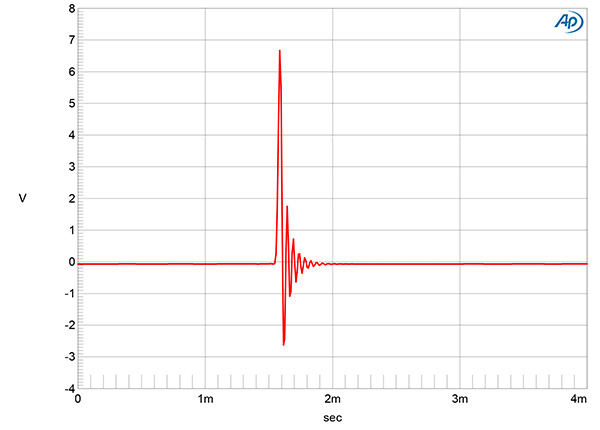
Seven reconstruction filters are listed in the touchscreen's DAC settings window: Fast and Slow Rolloff Minimum Phase, Fast and Slow Linear Phase, "Brickwall," "Apodizing," and "MQA Custom Apodizing," similar to those offered by Mytek's earlier Manhattan D/A preamplifier. The display indicated that Fast Rolloff Minimum Phase was the active filter. If I attempted to choose a different filter with the touchscreen, my choice was confirmed by the display, but the Brooklyn Bridge II's impulse response with 44.1kHz data (fig.1) remained the same, a short minimum-phase type with a small amount of ringing following the single sample at 0dBFS.
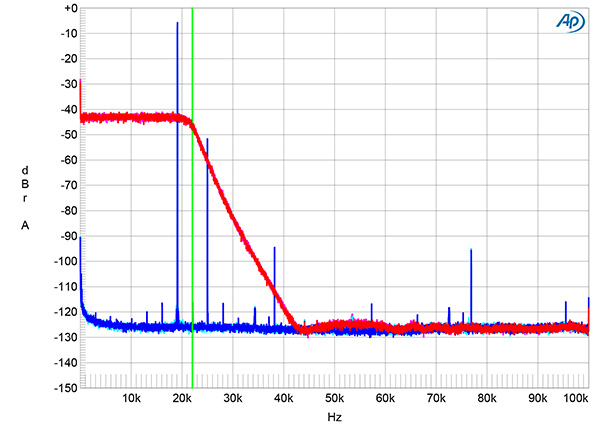
With 44.1kHz-sampled white noise (fig.2, red and magenta traces), the Brooklyn Bridge II's filter response was the same as I have found with the filter used by MQA decoders/renderers for non-MQA data (footnote 1). It doesn't reach full stop-band suppression until 44.1kHz. An aliased image at 25kHz of a full-scale tone at 19.1kHz (blue and cyan traces) can be seen at –50dB, though the distortion harmonics of the 19.1kHz tone are all very low in level. The behavior shown in figs.1 and 2 was identical with all digital inputs: S/PDIF, USB, and Roon. It is possible that this was associated with Roon identifying the Brooklyn Bridge II as a full MQA decoder and renderer.
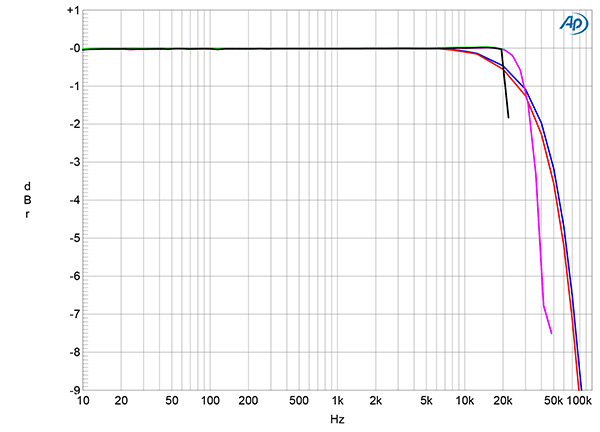
The Mytek's frequency response with data sampled at 44.1 and 96kHz via S/PDIF, and 192kHz via Roon, is shown in fig.3. The response with 192kHz data (blue and red traces) rolls off with a slightly slower slope than at the lower sample rates. Channel separation was excellent, at >110dB in both directions and still 90dB at the top of the audioband. Even with the volume control set to its maximum, the low-frequency noisefloor (fig.4) was very low in level despite the presence of supply-related spuriae at 60Hz and its odd-order harmonics. These low-level spuriae—all at or below –100dB ref. 0dBFS—are due to magnetic interference from the power transformer. This graph was taken from the single-ended preamplifier outputs; from the balanced outputs, the levels of the random noise and supply interference were approximately 6dB lower.

TF reported that he heard "computer-like" noises via the Mytek's unbalanced outputs. I attempted to reproduce this result. With the Brooklyn Bridge II's Bluetooth and Wi-Fi connections active but not paired, I listened to the Audio Precision's monitor (headphone) output for several minutes as the Brooklyn Bridge II played a dithered 24-bit 1kHz tone at –90dBFS with Roon. Later, I repeated this with loudspeakers via the unbalanced analog outputs. I heard the tone and some AC supply–related hum, but I heard no other unusual noises.
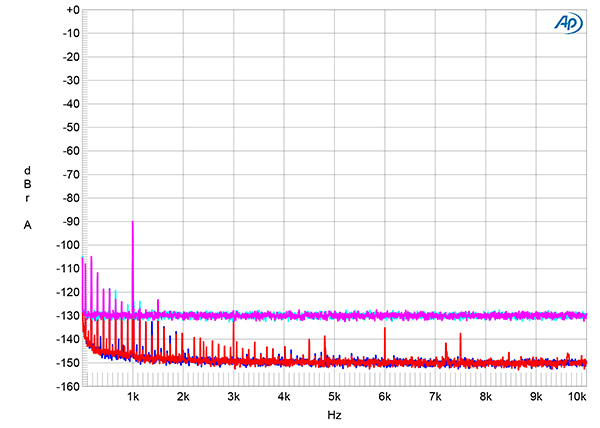
Increasing the bit depth from 16 to 24 with this dithered, 1kHz tone at –90dBFS lowered the noisefloor by 20dB (fig.5), meaning that the Brooklyn Bridge II offers between 18 and 19 bits' worth of resolution. Note, however, the presence of low-level power supply–related spuriae in this graph. With undithered data representing a tone at exactly –90.31dBFS (not shown), the three DC voltage levels described by the data were well resolved, and the waveform was perfectly symmetrical. With undithered 24-bit data, the result was a clean sinewave (also not shown).
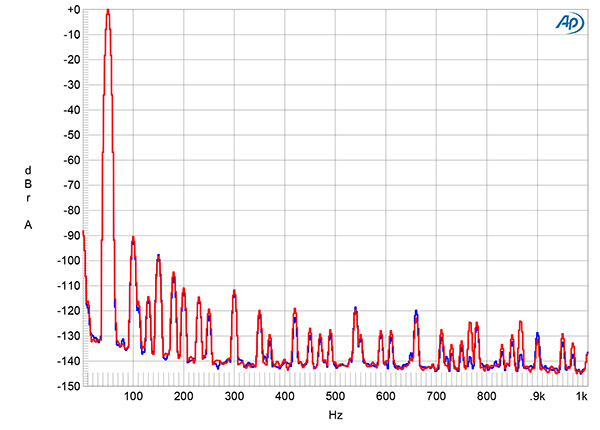
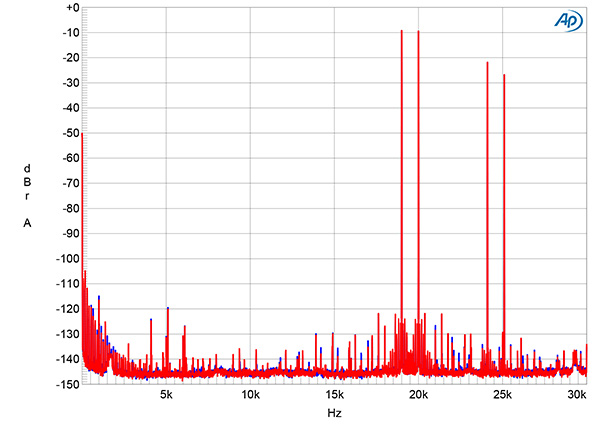
Even with the punishing 600 ohm load impedance, harmonic distortion was very low (fig.6), with the second harmonic the highest in level at –90dB (0.03%). With an equal mix of 19 and 20kHz tones with a peak level of –3dBFS, the second-order intermodulation product at 1kHz lay at a very low –114dB (0.0002%, fig.7), and the higher-order products at 18kHz and 21kHz were even lower in level. As I expected from fig.2, the aliased images of the primary tones were present in this graph.
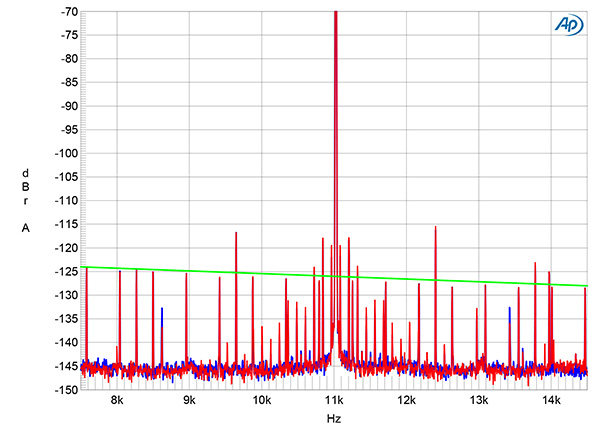
The Mytek's rejection of word-clock jitter with 16-bit J-Test data (fig.8) was puzzling. Although all the odd-order harmonics of the LSB-level, low-frequency squarewave are at the correct levels, indicated by the sloping green line in this graph, some power supply–related sidebands are present on either side of the high-level tone at one-quarter the same rate, as is a higher-level pair of sidebands at ±1380Hz. This graph was taken with Roon data; repeating the analysis with S/PDIF data gave an identical result.
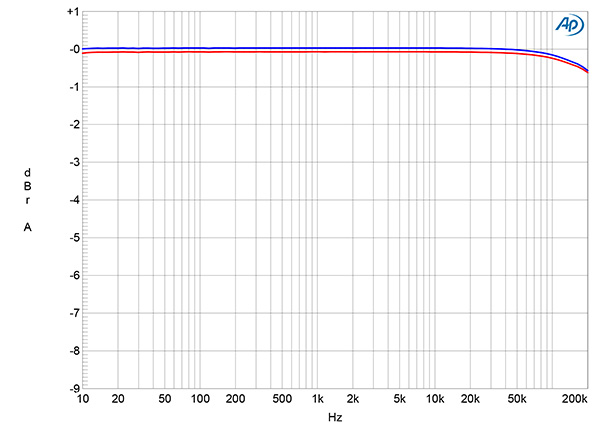
Turning to the single-ended analog line inputs: With the Mytek's volume control set to its maximum, the voltage gain at 1kHz measured 9.55dB from the balanced preamplifier outputs and the headphone outputs and 3.55dB from the single-ended outputs. The line input inverted absolute polarity from the preamplifier outputs and the left-hand headphone jack but preserved polarity from the right-hand headphone jack. The input impedance is specified as 10k ohms; I measured 9910 ohms at 20Hz and 1kHz, 9660 ohms at 20kHz. The frequency response was flat from 10Hz to 100kHz (fig.9), and channel separation was excellent, at >100dB over most of the audioband and still >90dB at 20kHz.
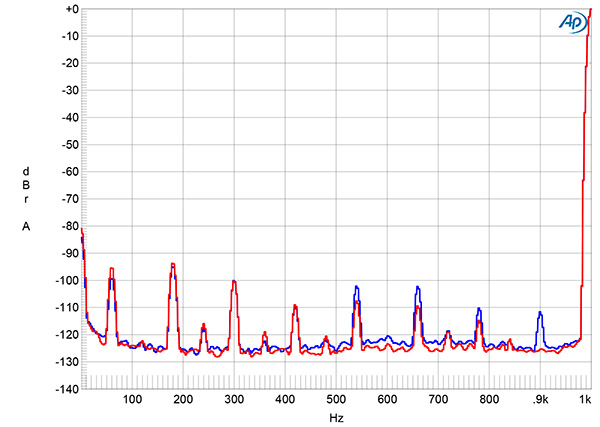
With the Brooklyn Bridge II's line inputs shorted to ground and the volume control set to its maximum, the wideband, unweighted signal/noise ratio (ref. 1V) measured 76.5dB in both channels at the balanced outputs and 81.3dB at the single-ended outputs. Restricting the measurement bandwidth to 22kHz increased those ratios to 83.9dB balanced and 87dB single-ended; an A-weighting filter increased them further, to 89.8dB balanced, 94dB single-ended. Spectral analysis of the Mytek's low-frequency noisefloor (fig.10) revealed the same power supply–related spuriae that were present with the digital inputs, at similar levels. This graph was taken with the balanced outputs; the spectrum was identical from the single-ended outputs.
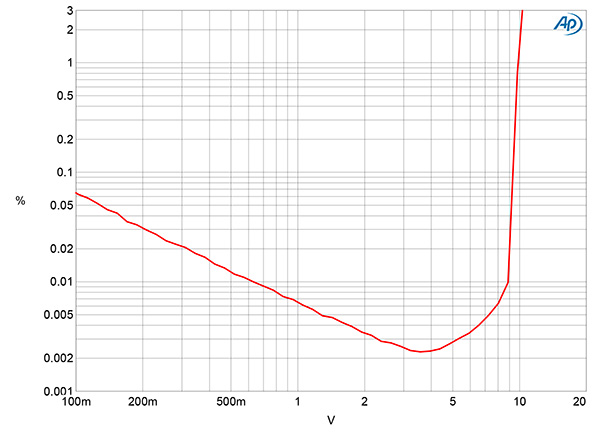
Fig.11 shows how the THD+noise percentage in the balanced output changed as the output voltage into 100k ohms increased. (The volume control was set to –12dB for this measurement to avoid overloading the input stage.) The downward slope below 5V output is due to actual distortion lying below the noisefloor. The distortion starts to rise above that output level but is still very low. The balanced output clipped at a high 10.1V into this load; the unbalanced output clipped at half that voltage, as expected. The balanced clipping voltage into the punishing 600 ohms load was 8V—the Brooklyn Bridge II has a bombproof output stage!
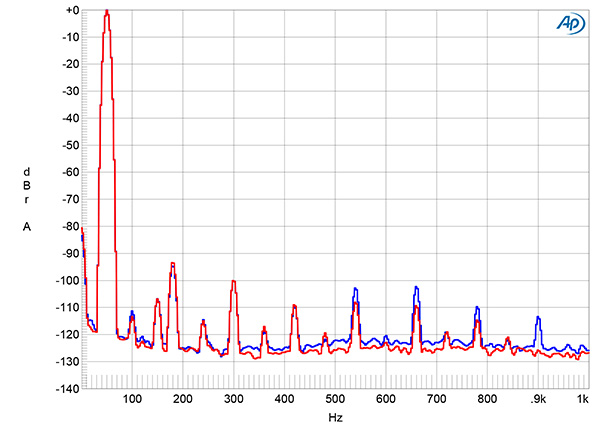
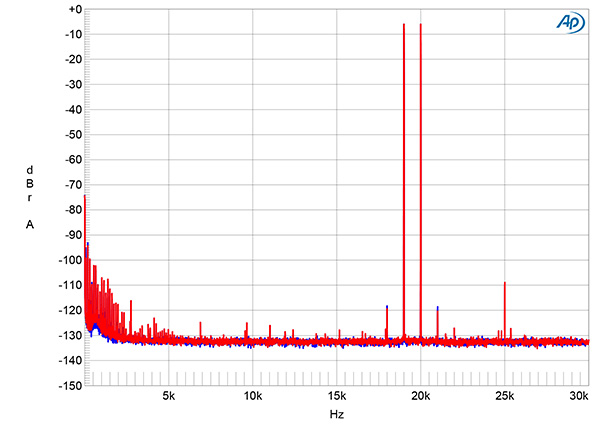
The distortion in both types of output was very low at all audio frequencies, and the distortion signature appears to be primarily second- and third-harmonic in nature (fig.12)—both harmonics vanishingly low in level. Intermodulation distortion was also extremely low (fig.13).
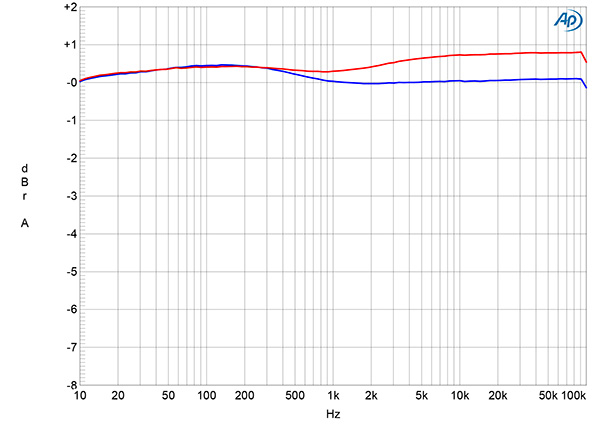
To examine the performance of the Mytek's phono input, I connected a wire from the Audio Precision's ground terminal to the grounding lug on the Mytek's rear panel. This input preserved absolute polarity at the preamplifier outputs in both MM and MC modes, with the same inverting/noninverting behavior at the two headphone jacks as seen with the digital inputs. The input impedance in MM mode measured 60k ohms at 20Hz, 62k ohms at 1kHz, and 42.5k ohms at 20kHz. In MC mode, the impedance was 980 ohms across the audioband. In MM mode, the maximum gain at 1kHz was an appropriate 49.4dB at the balanced and headphone outputs, 43.4dB at the unbalanced outputs. The gains in MC mode were 17dB higher. The phono input's RIAA correction (fig.14) was relatively accurate but with a 0.8dB rise above 10kHz in the right channel's output.
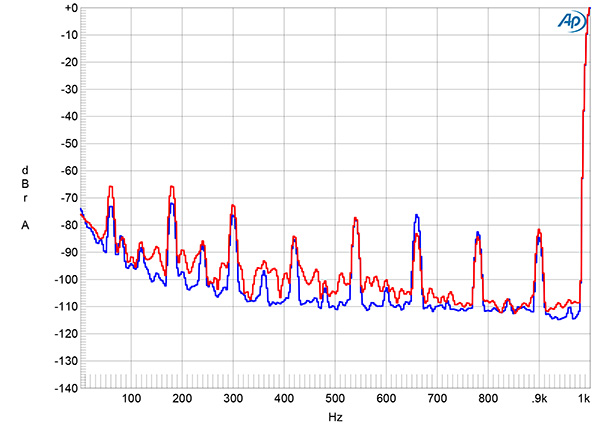
The phono input's wideband, unweighted S/N ratio in MM mode with the inputs shorted to ground was an okay 57.4dB in the left channel, 54dB in the right channel, both ref. 1kHz at 5mV. Restricting the measurement bandwidth to the audioband didn't increase the ratios, while inserting an A-weighting filter resulted in ratios of 64.7dB, left, and 68.2dB, right. These ratios were all 24dB worse in MC mode, ref. 1kHz at 500µV, which means this mode is disappointingly noisy. The phono input's noisefloor was dominated by power supply–related spuriae at 60Hz and its odd-order harmonics (fig.15). Note however that, as usual, I was measuring these S/N ratios and spectra with the volume control set to its maximum. The level of the noise dropped at lower volume control settings but was still high in MC mode. For example, its A-weighted S/N ratio ref. 1kHz at 500µV was 43dB with the volume control set to its maximum, 55dB with the control set to –20dB or lower.
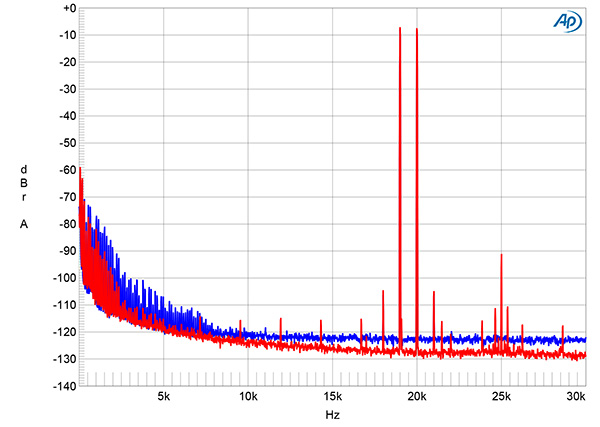
The phono input's overload margins in MM mode, ref. 1kHz at 5mV, were good, at 17dB at 20Hz and 1kHz, 13.6dB at 20kHz. In MC mode, ref. 1kHz at 500µV, the margins at all audio frequencies were 3dB higher than in MM mode. The second harmonic was the highest in level in the phono input's distortion signature but at –90dB (0.003%) was inconsequential. The levels of the intermodulation products with an equal mix of 19 and 20kHz tones were also very low (fig.16).
Via its digital and analog line inputs, Mytek's Brooklyn Bridge II offers generally excellent measured performance. However, the phono input's noise level in MC mode is disappointing. Having a linear power supply in such a small chassis results in higher-than-usual levels of magnetic power transformer–related interference.—John Atkinson

this is indeed a legitimate question: should a streamer (Bridge) be seen, used & reviewed only as a roon endpoint to a PC running roon which would then be the actual streamer (that manages data streams, playlists etc from different internet based music sources)?
Is it sufficient to see the Bridge only as an endpoint that just converts externally preassembled data stream into usb, or similar, for DA-Conversion?
I bet Mytek do their own streamer SW that allows to directly run Qubuz & Co (and perhaps not at lower quality), however, that point was not addressed - or did I just missed it? Also, control SW (the app) and usability is important to happiness or absence thereof.
best regards
hb72

The files you put on the server are still yours to put on a NAS or other streaming server. I have a Roon server but also have a raspberry pi which can stream to DAC from my NAS, so that was less than $50, and since the Mytek works as a standalone DAC then you would be set. Granted it's barebones compared to Roon. Once you have your music on a NAS there are endless options. Of course the target market for this device may be less comfortable with patching together a tech based system, so point to you there.
Also, Roon is primarily a software company, so they don't run the same risks an audio equipment manufacturer does.

Thanks for feedback.
I am used to using Volumio Streaming SW, which integrates many sources and treats them all alike, e.g. local drives, local servers, all sorts of Streaming Platforms such as Qobuz, Tidal, Spotify, and Internet Radio stations etc; so you can put radio stations, songs, albums into your own playlists, all operated from your phone, to easily play, extend, and jump back where you want to: One SW! One Streamer device, and a phone, tablet or TV, nothing else; i.e. NO further powerful PC needed to buy, maintain, boot, make sure is around your hifi system. Also not necessary: cost for Roon license.
Most if not all Streamers come with some sort of their own control SW / UI SW. So, my expectation is that a review, such as the one above, would _also_ capture and rate that, if you want in comparison with Roon, Volumio, etc, w.r.t to its usability, features, reliability, as it really can make a difference to the musical journey and also the quality (SQ), the threshold to overcome for a non-nerd to reasonably operate the device.
best regards
hb72

Not an inexpensive device, but it does show how the streaming hardware market is truly evolving. Your recording background would lend you to notice noises, hums, and other artifacts that don't belong in the music, but being 76 and growing up with a transistor radio listening to WLS out of Chicago in my youth and thinking how great that was, it is funny about what we are complaining about today. And, it is really not complaining just pointing out performances issues that are audible in our nearly transparent audio world of today.
I did take your recommendation and ordered American Epic on Blu-ray and it will be here tomorrow off Amazon. Looking forward to that.
Your review had me thinking back to my first real system of a Fisher 500TX receiver, Dynaco A-25's and my Dual 1209 with a Pickering XV-750 cart. I later added a Teac 350 cassette deck and thought I had reached the heights. I really knew I had not as I could not afford the Bozak Concert Grands I lusted after. Then it was FM or physical media. No longer for sure.
I guess the real battle will be if the streaming services can start turning a profit. The issue with MQA shows how fragile things can be.
I have really been enjoying my recent purchase of the KEF Q-350 speakers, my first speaker buy in over 25+ years. I should not have waited so long, and and many may feel the same way about streaming.

"Via its digital and analog line inputs, Mytek's Brooklyn Bridge II offers generally excellent measured performance."
Line maybe, but digital? I can't see anything even approaching "generally excellent".
Mani.

Is Mytek actively fulfilling orders? Last I heard they hit pause due to very long-standing supply-chain issues

I have had an order in for 2 years since Sep 2021. Nothing. And I prepaid.
I think Mytek not only had issues with supply chain, but design problems.
MQA is going out. Roon is not much better than Tidal’s standard interface.
I am really concerned that Mytek can’t even respond to my inquiries.
Is this all a big scam.

I watched the entire 2-disc set in one sitting. My take is a mixed bag.
The early recording process and the gear is very interesting start to finish. It is amazing the ingenuity that began this recording of live events and to look at where we are today. Making those lacquers one at a time, each under 4 minutes in length; and I was surprised that in each remake they did not have a count-down timer on the wall for performers to know where they were close to the end of 3 1/2 minutes.
I would give RCA a lot of credit for taking their recording gear to the places that they did knowing how difficult travel was back in the late 1920's and later. Even the performers took the time to travel hundreds of miles with the chance to be "discovered".
The country music aspect of this was interesting and how far the quality of music has gone from the Carters until now, and how sophisticated it has become in comparison, but all music had to start somewhere.
I was also shocked and naive about how prevalent drug use was even back in that day, whether one might view this as recreational or not. What I did find interesting and sad was the connection that artist NAS made to the early blues and today's RAP is kind of a sad tale to me.
The movement into more complicated and sophisticated jazz later is really interesting and no doubt very academic in structure that really evolved over the decades. The fact, to me, is that RAP, 90+ years later, is just an extension of those early 1920's recordings from Memphis and New Orleans is troublesome to me only with even more negative lyrics. It was easy to understand where these early music compositions came from due to very sad circumstances of the performer's lives, often a very cruel existence.
There will be some who take exception to my thoughts on this and I do not minimize what those folks went through and how they best tried to make music even in their jug bands and wash-tub bass instruments due to a lack of money for real instruments.
All in all an interesting look at early American music and that it is now archived is really a miracle. Thanks for the heads-up on these discs. I have really enjoyed all of the "Now Hear This" series from PBS and presented by Scott Yoo. I own all of those as well.